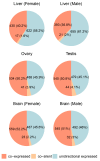Genomic Analysis and Functional Validation of Bidirectional Promoters in Medaka (Oryzias latipes)
- PMID: 39769487
- PMCID: PMC11676430
- DOI: 10.3390/ijms252413726
Genomic Analysis and Functional Validation of Bidirectional Promoters in Medaka (Oryzias latipes)
Abstract
Bidirectional promoters (BDPs) regulate the transcription of two adjacent, oppositely oriented genes, offering a compact structure with significant potential for multigene expression systems. Although BDPs are evolutionarily conserved, their regulatory roles and sequence characteristics vary across species, with limited studies in fish. Here, we systematically analyzed the distribution, sequence features, and expression patterns of BDPs in the medaka (Oryzias latipes) genome. A total of 1737 divergent gene pairs, representing 13% of medaka genes, were identified as potentially regulated by BDPs. These genes are enriched in essential biological processes, including organelle function, RNA processing, and ribosome biogenesis. Transcriptomic analysis revealed that co-regulation (co-expression and co-silencing) is a prominent feature of these gene pairs, with variability influenced by tissue and sex. Sequence analysis showed that medaka BDPs are compact, with most fragments under 400 bp and an average GC content of 42.06%. Validation experiments confirmed the bidirectional transcriptional activity of three histone-related BDPs in both medaka SG3 cells and embryos, demonstrating effective and robust regulatory efficiency. This study enhances our understanding of the genomic organization and transcriptional regulation in fish and provides a valuable reference for developing species-specific multigene expression systems in fish genetic engineering.
Keywords: bidirectional promoters; gene regulation; medaka; multigene expression.
Conflict of interest statement
The authors declare no conflict of interest.
Figures








Similar articles
-
Tissue-specific transcriptome assemblies of the marine medaka Oryzias melastigma and comparative analysis with the freshwater medaka Oryzias latipes.BMC Genomics. 2015 Feb 27;16(1):135. doi: 10.1186/s12864-015-1325-7. BMC Genomics. 2015. PMID: 25765076 Free PMC article.
-
Genomic organization and embryonic expression of miR-430 in medaka (Oryzias latipes): insights into the post-transcriptional gene regulation in early development.Gene. 2010 Jan 1;449(1-2):41-9. doi: 10.1016/j.gene.2009.09.005. Epub 2009 Sep 19. Gene. 2010. PMID: 19770025
-
Characterization of a nervous system-specific promoter for growth-associated protein 43 gene in Medaka (Oryzias latipes).Brain Res. 2008 Dec 15;1245:1-15. doi: 10.1016/j.brainres.2008.09.071. Epub 2008 Oct 7. Brain Res. 2008. PMID: 18951884
-
The genomic and genetic toolbox of the teleost medaka (Oryzias latipes).Genetics. 2015 Apr;199(4):905-18. doi: 10.1534/genetics.114.173849. Genetics. 2015. PMID: 25855651 Free PMC article. Review.
-
The medaka genome: why we need multiple fish models in vertebrate functional genomics.Genome Dyn. 2006;2:165-182. doi: 10.1159/000095103. Genome Dyn. 2006. PMID: 18753778 Review.
References
MeSH terms
Grants and funding
LinkOut - more resources
Full Text Sources
Miscellaneous

